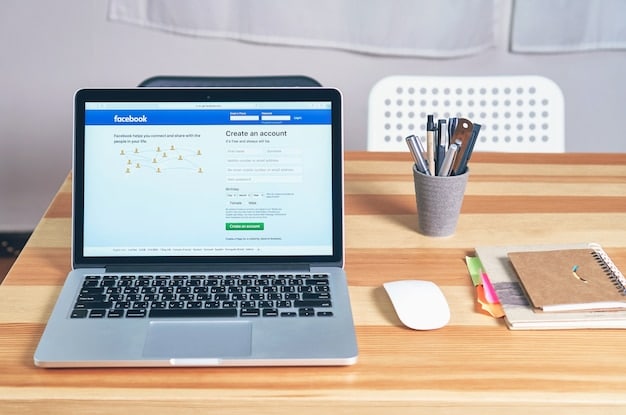LinkedIn Lead Gen Forms: Unlocking B2B Marketing Potential in US

Navigating the intricate landscape of B2B marketing in the US, LinkedIn Lead Gen Forms emerge as a powerful, yet often underutilized, tool for directly capturing high-quality leads, streamlining the conversion funnel, and providing invaluable data for strategic optimization.
In the dynamic realm of B2B marketing, the quest for efficient, high-quality lead generation is ceaseless. While numerous platforms promise results, the true potential often lies in leveraging niche, powerful tools. This article delves into the Insider Knowledge: The Untapped Potential of LinkedIn Lead Gen Forms for B2B Marketing in US, revealing how they can revolutionize your lead acquisition strategy.
Understanding the B2B Landscape in the US and the Role of LinkedIn
The business-to-business (B2B) market in the United States is characterized by its scale, complexity, and the strategic importance of every lead. Unlike B2C, B2B sales cycles are typically longer, involve multiple stakeholders, and hinge on building trust and demonstrating clear return on investment. In this environment, LinkedIn stands out as an indispensable platform, acting as the digital town square for professionals.
LinkedIn goes beyond merely connecting professionals; it’s a rich repository of professional data, career histories, company insights, and industry affiliations. For B2B marketers, this translates into an unparalleled opportunity to target decision-makers with precision. The platform’s professional ethos, coupled with its vast user base, makes it a prime location for lead generation, where the intent to engage with business-related content is inherently higher than on other social media channels. Therefore, understanding how to harness the specific tools LinkedIn offers becomes paramount for competitive advantage.
The Nuances of US B2B Marketing
US B2B marketing often involves navigating strict regulatory landscapes, diverse industry sectors, and a highly competitive digital space. Companies are constantly seeking innovative ways to cut through the noise and reach their ideal clients. This requires a nuanced approach that combines broad reach with hyper-targeted messaging. Traditional methods, while still having their place, are increasingly being supplemented, if not supplanted, by digital strategies that offer better tracking and optimization capabilities.
- Regulatory Compliance: Adhering to US data privacy laws like CCPA (California Consumer Privacy Act) is crucial.
- Market Diversity: Tailoring campaigns to specific industries (e.g., tech, healthcare, manufacturing) is key.
- Competition: Standing out requires distinct value propositions and efficient lead capture mechanisms.
The imperative for US B2B marketers is not just to generate leads, but to generate qualified leads that align with their ideal customer profile, minimizing wasted resources and maximizing conversion potential. This is where the power of integrated platforms like LinkedIn, with its robust advertising and lead generation features, truly comes into play for US-based businesses targeting domestic or international markets.
By leveraging LinkedIn’s professional ecosystem, B2B marketers can access a highly engaged audience of professionals actively seeking solutions and insights. This environment fosters a more receptive audience for B2B offerings, making LinkedIn an essential channel for any serious B2B lead generation strategy aiming to succeed within the US market, providing a direct conduit to decision makers and influencers.
What are LinkedIn Lead Gen Forms and Why They Matter
LinkedIn Lead Gen Forms are an integrated feature within LinkedIn’s advertising platform designed to simplify the lead capture process. When a user clicks on a LinkedIn Ad (such as a Sponsored Content or Message Ad), the lead gen form pre-fills with the user’s LinkedIn profile data, such as name, email address, job title, and company. This eliminates the need for users to manually type in their information, significantly reducing friction in the conversion process.
The magic lies in this pre-fill functionality. It’s a common challenge for marketers to see high click-through rates on ads but low conversion rates on landing pages, often due to lengthy forms or slow loading times. LinkedIn Lead Gen Forms directly address this by cutting out a significant portion of that friction. For B2B marketers, where time is a valuable commodity for both the advertiser and the prospect, this efficiency is not just a convenience, it’s a competitive advantage.
Key Benefits for US B2B Marketers
The advantages of integrating Lead Gen Forms into a B2B marketing strategy, particularly in the US, are multifaceted. They extend beyond mere convenience, impacting the quality of leads, the cost-effectiveness of campaigns, and the overall efficiency of the sales pipeline.
- Enhanced Conversion Rates: The pre-filled nature dramatically boosts conversion rates by simplifying the user experience. A prospect is more likely to complete a form that requires just one or two clicks rather than typing out several fields, especially on mobile devices.
- High-Quality Leads: Because the data comes directly from a professional’s LinkedIn profile, it tends to be more accurate and up-to-date than self-reported information on external landing pages. This means marketers are receiving higher quality, more reliable lead data, which is crucial for B2B segmentation and personalization.
- Mobile Optimization: Lead Gen Forms are inherently optimized for mobile, providing a seamless experience for users on the go. This is increasingly important as professionals access content and information from various devices.
- Rich Data Insights: Advertisers gain access to valuable data about their leads, which can be integrated directly into CRM systems. This allows for better lead nurturing, detailed segmentation, and more effective sales follow-ups, transforming raw contacts into actionable intelligence.
- Cost Efficiency: By improving conversion rates, these forms effectively lower the cost per lead (CPL). Marketers utilize their ad spend more efficiently, acquiring more qualified leads for the same investment, improving ROI significantly across their B2B campaigns.
The ability to capture accurate, relevant data with minimal effort from the prospect is a game-changer. For US B2B companies competing in a crowded market, harnessing Lead Gen Forms means not just collecting leads, but collecting better leads, faster, and more affordably. This positions them to move prospects more effectively through the sales funnel, leading to stronger business outcomes and sustained growth.
Crafting Compelling Ad Creatives that Drive Form Completions
The effectiveness of LinkedIn Lead Gen Forms hinges not just on their technical efficiency, but critically on the appeal of the ad creatives that precede them. A perfectly structured form is useless if the ad fails to capture attention and motivate a click. For B2B audiences in the US, who are often discerning and time-poor, ad creatives must be highly relevant, value-driven, and professionally presented to entice engagement.
Crafting compelling ad creatives involves a deep understanding of your target audience, their pain points, and the solutions your business provides. It’s about more than just a catchy headline; it’s about a holistic approach that combines striking visuals, persuasive copy, and a clear call to action (CTA). The goal is to pique curiosity just enough for the user to want more, knowing that the next step, filling out the form, will be effortless.
Visuals: The First Impression
High-quality visuals are non-negotiable on LinkedIn. For B2B ads, this often means professional, clean imagery or videos that resonate with a business audience. Avoid stock photos that look overtly generic. Instead, opt for images that:
- Represent your brand professionally: Consistent branding, high resolution.
- Illustrate a problem or solution: Show, don’t just tell. Infographics or data visualizations can also be highly effective.
- Evoke professionalism and trust: Clean lines, relevant industry imagery, or authentic team photos.
Video content is increasingly engaging on LinkedIn. Short, concise videos (15-60 seconds) that quickly convey a benefit or showcase a product/service can significantly increase engagement. Remember, the visual is often the first element a user processes, so make it count.
Copywriting: Speaking to the Business Mind

Your ad copy must be precise, benefit-oriented, and address the specific needs of your B2B audience. Forget jargon and hyperbole. Focus on the value proposition clearly and concisely. Consider these elements:
Remember that the copy should be compelling enough to entice the click-through to the form without giving everything away. It’s a balance between intriguing the reader and providing enough information to establish credibility and relevance. Tailoring your message to resonate with specific industry challenges or roles within the US market can significantly improve ad performance and lead quality.
Ultimately, the synergy between compelling creatives and the seamless experience of Lead Gen Forms creates a powerful B2B marketing engine. By investing time in crafting ads that truly speak to your target audience’s needs and aspirations, you maximize the inherent efficiency of LinkedIn’s lead capture capabilities, turning casual browsers into qualified prospects.
Targeting Strategies: Reaching the Right B2B Audience in the US
Targeting is the cornerstone of any successful B2B marketing campaign, and on LinkedIn, its precision is what sets it apart. Given the detailed professional data LinkedIn users provide, marketers have access to an unparalleled ability to define their ideal customer profile (ICP) and reach them with pinpoint accuracy. For US-based B2B marketing, strategic targeting means not just broadly casting a net, but specifically angling for decision-makers and influencers within relevant industries and companies.
Effective targeting ensures that your valuable ad spend reaches those most likely to convert, leading to higher quality leads and a more efficient sales cycle. It’s about minimizing waste and maximizing relevance, translating into better ROI for your LinkedIn Lead Gen Form campaigns.
Leveraging LinkedIn’s Robust Targeting Options
LinkedIn offers a rich array of targeting criteria, allowing marketers to build highly specific audience segments. Some of the most powerful options for B2B marketers in the US include:
- Job Title/Function: Target specific roles (e.g., “VP of Marketing,” “CFO,” “Sales Director”).
- Company Name/Industry: Focus on companies by specific names, or across entire industries (e.g., “Software Development,” “Healthcare,” “Financial Services”).
- Seniority: Reach decision-makers (e.g., “Director,” “VP,” “Owner”).
- Skills: Target individuals based on competencies listed on their profiles, indicating specific expertise or interests.
- Company Size: Is your solution best for SMBs or enterprises? Filter by employee count.
- Location: Crucial for identifying US-based prospects, whether by state, city, or designated market area (DMA).
Combining these criteria allows for the creation of highly refined audiences. For instance, you could target “Marketing Directors at Tech Companies in California with 500+ Employees.” The narrower the focus, often the higher the relevancy and conversion rate, provided the audience size remains viable.
Advanced Targeting Techniques for US Markets
Beyond the standard options, LinkedIn provides advanced techniques that can significantly enhance B2B targeting precision:
Look-alike Audiences: Upload a list of your existing high-value customers (e.g., email addresses) and LinkedIn will find new prospects who share similar attributes with your current customer base. This is particularly effective for scaling successful campaigns in the US market.
Retargeting: Engage users who have previously interacted with your website, LinkedIn Page, or watched your video ads. These individuals are already familiar with your brand, making them warmer leads and more likely to complete a Lead Gen Form. This is an excellent strategy for nurturing prospects who are already in your funnel.
Account Targeting (Matched Audiences – Account List): Upload a list of specific target companies you want to reach. LinkedIn matches these companies to its database, allowing you to run ads directly to employees of those dream accounts. For ABM (Account-Based Marketing) strategies common in the US B2B space, this is an indispensable tool.
The ability to granularly slice and dice LinkedIn’s vast professional network means that B2B marketers aren’t just advertising; they’re engaging in highly strategic outreach. By meticulously defining and targeting their audience using these robust features, US businesses can ensure their LinkedIn Lead Gen Forms campaigns capture the most relevant and valuable leads, driving actual business growth rather than just impressions.
Optimizing Lead Gen Forms for Maximum US B2B Conversions
While the inherent efficiency of LinkedIn Lead Gen Forms is a significant advantage, their true potential is unlocked through strategic optimization. It’s not enough to simply use them; B2B marketers in the US must fine-tune every aspect to ensure they are capturing the highest quality leads at the lowest possible cost. Optimization involves a continuous cycle of testing, analyzing, and refining the form fields, the content offer, and the post-submission experience.
The goal is to strike a delicate balance: gather enough information to qualify a lead effectively without creating unnecessary friction that might lead to abandonment. This balance is particularly crucial in the US B2B context, where decision-makers are busy and value swift, relevant interactions.
Form Field Management: Quality vs. Quantity
One of the most critical aspects of optimizing Lead Gen Forms is deciding which fields to include. LinkedIn automatically pre-fills many standard fields (name, email, company, job title), which is a great start. However, if you need more specific qualification data, you can add custom questions. The key principle here is minimalism:
- Minimize Fields: Every additional field increases the chance of abandonment. Only ask for information that is absolutely essential for lead qualification and sales follow-up.
- Leverage Pre-filled Data: Rely heavily on the data LinkedIn provides directly from profiles. This is accurate and requires no user effort.
- Strategic Custom Questions: If you must ask custom questions, make them either multiple-choice or very quick to answer. Examples might include “Company Size,” “Industry Focus (if not covered by LinkedIn’s standard fields),” or “Specific Product Interest.”
For US B2B, ensure any custom questions are relevant to legal and compliance needs (e.g., if you’re offering certain services, confirming state of operation might be necessary). The less brainpower and manual effort required from the user, the higher your completion rates will be.
Content Offer Alignment and Post-Submission Strategy
The content offer or lead magnet associated with your Lead Gen Form is paramount. It must be highly valuable and directly relevant to your target audience. Examples for US B2B might include:
- Exclusive whitepapers or research reports on industry trends.
- Access to a B2B webinar featuring industry leaders.
- A demo or free trial of a SaaS product.
- An industry-specific toolkit or template.
The offer should align perfectly with the ad creative that drove the click. A disconnect here can lead to high bounce rates even after form submission. Once a form is submitted, the journey doesn’t end; it’s just beginning. The post-submission strategy is vital:
- Thank You Page/Message: Immediately confirm submission and set expectations for next steps.
- Email Nurturing: Integrate leads into an automated email nurturing sequence that delivers the promised content and then continues to provide value, moving them down the sales funnel.
- CRM Integration: Ensure seamless integration with your CRM (e.g., Salesforce, HubSpot). This allows your sales team to receive new leads instantly, track their journey, and initiate timely outreach.
By optimizing form fields for minimal friction, offering highly relevant content, and establishing a robust post-submission strategy, US B2B marketers can maximize the effectiveness of their LinkedIn Lead Gen Forms, translating clicks into qualified, actionable leads ready for conversion.
Measuring Success and Iterative Optimization for B2B Campaigns
In the data-driven world of B2B marketing, measuring success is not just about counting leads; it’s about understanding the quality of those leads, their journey through the sales funnel, and the overall return on investment (ROI). For LinkedIn Lead Gen Forms, continuous measurement and iterative optimization are crucial for achieving sustainable growth and maximizing the potential of this powerful tool, particularly in the competitive US market.
Data provides the insights needed to refine targeting, improve ad creatives, and even adjust the content offer. This methodical approach ensures that marketing spend is optimized, and campaigns consistently deliver against business objectives. Without robust analytics and a commitment to refining based on performance, even the most promising lead generation strategies can fall short.
Key Metrics for LinkedIn Lead Gen Forms
To effectively measure campaign performance, B2B marketers should focus on a combination of primary and secondary metrics:
- Cost Per Lead (CPL): This is arguably the most critical metric. It tells you how much you’re paying to acquire each lead. A declining CPL indicates greater efficiency.
- Conversion Rate: The percentage of ad clicks that result in a form submission. A higher conversion rate suggests that your ad creative, targeting, and form are well-aligned.
- Lead Quality: This is a qualitative metric, often determined by the sales team. Are the leads generated by Lead Gen Forms qualified? Are they moving through the sales funnel? This can be tracked through CRM integration and sales feedback.
- Click-Through Rate (CTR): While not directly about conversions, CTR indicates the effectiveness of your ad creatives in capturing attention.
- Impressions and Reach: Provide context on the scale and visibility of your campaigns.
Beyond these, it’s also important to track the post-conversion metrics such as lead-to-opportunity rate, opportunity-to-win rate, and ultimately, the customer lifetime value (CLTV) generated from these leads. This holistic view helps in understanding the true impact of LinkedIn Lead Gen Forms on revenue.
Iterative Optimization: The Path to Better Performance
Optimization is not a one-time task but an ongoing process. Based on the metrics collected, marketers should continuously test and refine various aspects of their campaigns:
A/B Testing Ad Creatives: Experiment with different headlines, ad copy, images, and videos. Test various calls to action to see what resonates best with your US B2B audience. Small tweaks can yield significant improvements in CTR and conversion rates.
Refining Targeting Parameters: Analyze which target segments yield the highest quality leads or lowest CPL. Are certain job titles more responsive? Do leads from specific industries convert better? Adjust your targeting to focus more on these high-performing segments.
Optimizing Form Fields: If your conversion rate is lower than desired, consider reducing the number of form fields. If lead quality is an issue, consider adding a strategic custom qualifying question. It’s a continuous balance to achieve.
Landing Page/Post-Submission Experience: While Lead Gen Forms eliminate the need for a separate landing page for lead capture, the immediate post-submission experience (thank you message, automated email sequence) still matters. Ensure it’s seamless and delivers the promised value promptly.
Budget Allocation: Shift budget toward campaigns and ad sets that demonstrate the best CPL and lead quality. This data-driven allocation of resources ensures that your marketing spend is always working as hard as possible for your US B2B objectives. Regular reporting and analysis, coupled with a willingness to experiment, will pave the way for increasingly effective LinkedIn Lead Gen Form campaigns.
Integrating Lead Gen Forms with Your B2B Sales & Marketing Funnel
The true power of LinkedIn Lead Gen Forms extends beyond mere lead capture; it lies in their seamless integration into the broader B2B sales and marketing funnel. For US businesses, a disconnected lead generation process can cripple sales efforts, leading to missed opportunities and wasted resources. Effective integration ensures that leads flow smoothly from LinkedIn into a company’s sales backend, enabling timely follow-up, personalized nurturing, and accurate attribution.
This holistic approach transforms Lead Gen Forms from a standalone tool into a critical component of a cohesive, revenue-generating machine. Without proper integration, even the highest quality LinkedIn leads can languish, losing their value over time.
CRM Integration: The Sales Team’s Best Friend
Direct integration of LinkedIn Lead Gen Forms with your Customer Relationship Management (CRM) system is non-negotiable for efficient B2B operations. Most major CRMs (like Salesforce, HubSpot, Zoho CRM, Microsoft Dynamics) offer native integrations or can be connected via third-party tools (like Zapier). This integration achieves several critical objectives:
- Instant Lead Transfer: As soon as a user submits a Lead Gen Form, their details are automatically pushed into your CRM. This eliminates manual data entry, reducing errors and saving valuable time.
- Timely Follow-up: Sales teams can be instantly notified of new leads, allowing for rapid follow-up. In B2B, the speed of response significantly impacts conversion rates.
- Lead Assignment: New leads can be automatically assigned to the correct sales representative based on pre-defined rules (e.g., industry, company size, geographic location within the US).
- Comprehensive Lead Tracking: Sales reps have immediate access to all the information gathered by the Lead Gen Form, along with the ad details that generated the lead. This context helps them tailor their outreach and move the prospect further down the funnel.
Ensuring your CRM is set up to receive and process these leads effectively is paramount. This might involve creating specific lead stages, automated tasks, or follow-up sequences within the CRM itself.
Marketing Automation & Nurturing Workflows
Beyond sales, integrating Lead Gen Forms with your marketing automation platform (e.g., Marketo, Pardot, HubSpot Marketing Hub) enables sophisticated lead nurturing strategies. Once a lead enters your system, they can be enrolled in automated workflows designed to educate, engage, and qualify them further.
These workflows can include:
- Automated Email Sequences: Delivering the promised content, then a series of follow-up emails that provide additional value, share case studies, or invite them to product demos.
- Content Personalization: Based on the information collected from the Lead Gen Form (e.g., industry, job title), content can be dynamically personalized to resonate more deeply with the prospect’s needs.
- Lead Scoring: Assigning scores to leads based on their engagement with your content and other actions. This helps sales teams prioritize the most “sales-ready” leads.
- Retargeting Audience Building: Leads can be segmented for future retargeting campaigns on LinkedIn and other platforms, ensuring continued engagement.
For US B2B marketers, this integrated approach ensures that every lead generated by LinkedIn Lead Gen Forms is not just captured, but actively nurtured and moved through the sales pipeline in a systematic and efficient manner. This maximizes the value of each lead and drives tangible business outcomes.
Future Trends and Leveraging AI for Lead Gen Forms
The landscape of digital marketing is perpetually evolving, and B2B lead generation is no exception. As we look towards 2025 and beyond, several trends are poised to further amplify the effectiveness of LinkedIn Lead Gen Forms. Artificial Intelligence (AI) and machine learning stand at the forefront of these advancements, promising to inject unprecedented levels of precision, personalization, and efficiency into B2B marketing efforts, especially within the competitive US market.
Staying ahead of these trends will be crucial for B2B marketers who aim to maintain a competitive edge. The integration of cutting-edge AI capabilities with existing platforms like LinkedIn can transform how leads are identified, engaged, and converted, moving beyond traditional methods into a more predictive and proactive approach.
AI-Powered Targeting and Personalization
Today’s LinkedIn targeting is powerful, but AI promises to take it to the next level. Imagine AI algorithms analyzing vast datasets to identify “look-alike” audiences with far greater accuracy, not just based on demographics, but on psychographics, behavioral patterns, and intent signals. For US B2B, this could mean:
- Predictive Lead Scoring: AI can analyze historical data to predict which leads are most likely to convert, allowing sales teams to prioritize their efforts more effectively.
- Dynamic Ad Content: AI could potentially generate and optimize ad creatives in real-time, tailoring headlines, copy, and visuals to individual user preferences and behaviors, all before they even see the Lead Gen Form.
- Intent-Based Targeting: Leveraging AI to detect subtle signals of purchasing intent (e.g., recent job changes, company funding rounds, specific content consumption patterns) to target individuals actively seeking solutions in your space.
This level of precision means that the prospects who encounter your LinkedIn Lead Gen Forms will be even more highly qualified and receptive, leading to superior conversion rates and a healthier B2B pipeline.
Automated Personalization of Forms and Follow-up
While Lead Gen Forms already pre-fill data, AI could push personalization further. Imagine forms dynamically adjusting questions based on an individual’s profile or previous interactions. For instance, if AI detects a user is from a particular industry, the form might present a tailored, industry-specific question, rather than a generic one. This enhances the user experience and yields more granular data for sales.
Post-submission, AI can revolutionize lead nurturing. Instead of generic email sequences, AI-powered systems could:
- Adaptive Nurturing: Adjust the pace and content of follow-up emails based on a lead’s real-time engagement and behavior.
- Conversational AI: Integrate chatbots or conversational tools that engage leads immediately after form submission, answering questions, and further qualifying them before a sales rep steps in.
These AI advancements suggest a future where B2B lead generation via LinkedIn Lead Gen Forms becomes even more intuitive, efficient, and deeply personalized. For US businesses aiming for sustained growth, adopting these technologies will be crucial for not just capturing leads, but cultivating lasting, profitable B2B relationships.
| Key Point | Brief Description |
|---|---|
| 📈 High Conversion | Pre-filled forms significantly reduce friction, boosting lead capture rates. |
| ⭐ Quality Leads | Data directly from LinkedIn profiles ensures accuracy and relevance for B2B. |
| 🎯 Precise Targeting | Leverage LinkedIn’s robust options to reach specific US B2B decision-makers. |
| 🔗 Seamless Integration | Connect with CRM/marketing automation for efficient lead nurturing and sales. |
Frequently Asked Questions about LinkedIn Lead Gen Forms
▼
LinkedIn Lead Gen Forms are highly effective for B2B in the US due to their direct access to professional, pre-filled data, which significantly reduces friction for users. This leads to higher conversion rates of qualified leads, directly sourced from accurate LinkedIn profiles, making follow-ups more efficient and targeted for US businesses aiming for precise outreach.
▼
To ensure high lead quality, meticulously define your target audience using LinkedIn’s broad filtering options like job title, industry, and company size. Additionally, add a few strategic, qualifying custom questions to the form that are essential for lead prioritization, and ensure your content offer appeals specifically to your ideal customer profile, weeding out less relevant prospects.
▼
Common pitfalls include asking too many custom questions, which increases form abandonment rates, and neglecting the quality of your ad creative. A misaligned content offer, poor post-submission nurturing, or a lack of CRM integration can also severely limit the effectiveness of your Lead Gen Form campaigns. Always strive for a balance between data collection and user experience.
▼
Yes, LinkedIn Lead Gen Forms offer robust integration capabilities. Many popular CRM systems (e.g., Salesforce, HubSpot) have direct integrations, allowing leads to be automatically populated. For other platforms, third-party integration tools like Zapier can create seamless workflows. This ensures prompt follow-up, efficient lead nurturing, and comprehensive tracking within your existing B2B sales and marketing ecosystem.
▼
Mobile optimization is a significant benefit because a large percentage of LinkedIn users access the platform on their mobile devices. Lead Gen Forms are inherently designed for a seamless mobile experience, enabling quick, one-tap submissions without needing to zoom or type. This reduces friction and greatly improves conversion rates for professionals on the go, ultimately capturing more leads for B2B initiatives.
Conclusion
The journey through the intricate world of B2B marketing in the US consistently highlights the need for efficiency, precision, and high-quality lead generation. LinkedIn Lead Gen Forms, as explored throughout this article, stand out as a powerful, yet often underutilized, tool tailored precisely for these demands. Their inherent design, which leverages LinkedIn’s rich professional data for pre-filled forms, significantly reduces friction in the lead capture process, translating into higher conversion rates and more reliable lead data. By understanding the nuances of the US B2B landscape, crafting compelling ad creatives, employing sophisticated targeting strategies, and meticulously optimizing every stage from form fields to post-submission, marketers can unlock an unparalleled potential for growth. Furthermore, the seamless integration with CRMs and marketing automation platforms ensures that every captured lead is not merely a contact, but a step forward in a well-defined sales funnel. As AI continues to evolve, promising even greater personalization and predictive capabilities, the strategic importance of LinkedIn Lead Gen Forms for B2B marketers in the US is poised to grow even further, cementing their role as an indispensable asset for sustained business success and market leadership.





